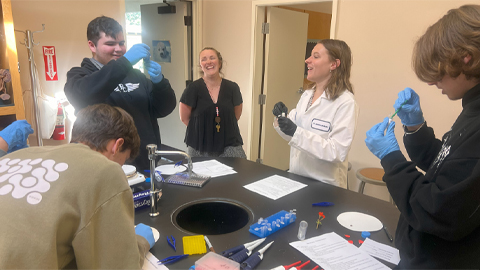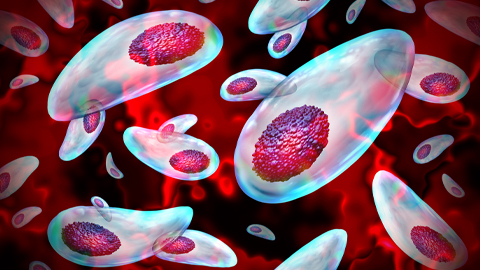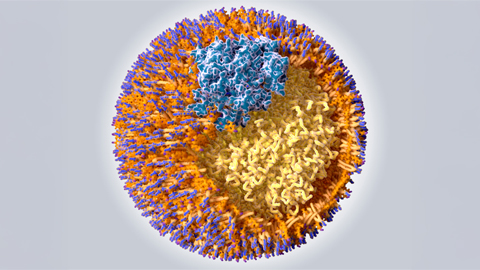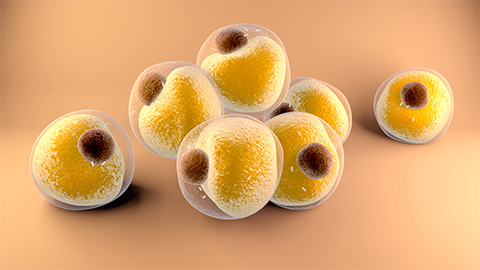From the journals: MCP
A new enzyme is unlocked in bacterial photosynthesis. A molecular target for alcohol consumption is uncovered. A special issue offers new perspectives in ECM research. Read about these papers recently published in the journal Molecular & Cellular Proteomics.
New enzyme unlocked in bacterial photosynthesis

Cyanobacteria, unique organisms capable of plant-like photosynthesis, are vital for producing oxygen and sustaining life on Earth. One specific cyanobacterial type, Synechocystis, was the first photosynthetic bacterium to be sequenced and is widely used as a model organism for studying photosynthesis and biotechnological applications.
Recent research has highlighted the significance of posttranslational modifications, or PTMs, in regulating photosynthesis in both cyanobacteria and plants. Lysine methylation, a specific PTM involving the addition of a methyl group to a protein's amino acid, has diverse functions in organisms. While researchers have studied it extensively in eukaryotes, they do not yet fully understand its role in bacteria (including cyanobacteria).
Gaoxiang Cao and a team at the Chinese Academy of Sciences in Wuhan recently analyzed the proteins in Synechocystis that have lysine methylation and found many proteins involved in photosynthesis that can be modified in this way. This reversible modification may play a role in regulating photosynthesis in both cyanobacteria and plants. However, researchers had not yet characterized the enzymes responsible for adding and removing the methyl group.
Lysine methyltransferase, or KMT, enzymes help with the transfer of methyl groups from S-adenosyl methionine molecules to proteins. The team focused on Synechocystisand unveiled a novel KMT named cKMT1. Experiments showed that cKMT1 could add methyl groups to lysine residues in proteins, both in controlled laboratory settings and within cells. Additionally, the researchers observed that cKMT1 modifies a crucial protein called ferredoxin-NADP(+) oxidoreductase and influences its activity, indicating its role in regulating energy transfer in Synechocystis.
The findings, recently published in the journal Molecular & Cellular Proteomics, provide insights into the regulation of photosynthesis in cyanobacteria. Understanding this new KMT and its function enhances our global comprehension of photosynthesis and holds promise for future potential biotechnological applications.
Molecular target for alcohol consumption uncovered
Protein kinase C epsilon, or PKCε, a crucial signaling molecule within cells, plays a significant role in transmitting signals and influences various cellular functions. In research studies, it has been particularly implicated in modulating behavioral responses to alcohol consumption and anxiety.
Michael P. Dugan and a team at the University of Texas at Austin conducted a study using innovative techniques to explore PKCε's role in alcohol and anxiety. They used chemical-genetic methods and mass spectrometry on mouse brain lysates, identifying 39 protein substrates directly interacting with PKCε, including known and novel interactors.
Among those known to interact with PKCε (such as myristoylated alanine-rich C-kinase substrate), associations were found with alcohol-related and anxiety-related behaviors. Additionally, numerous novel PKCε substrates (such as BR serine/threonine kinase 1 and Abelson interactor 1) emerged that were unrelated to alcohol and anxiety but involved in critical cellular functions, such as cytoskeleton maintenance and synaptic activity.
The study , published in Molecular & Cellular Proteomics, presents a list of proteins that could be potential targets for developing drugs to reduce alcohol consumption and anxiety in humans. Furthermore, these proteins may serve as biomarkers to detect abnormal PKCε activity in diseases like cancer and Alzheimer's, paving the way for new therapeutic avenues.
Perspectives in ECM research
The extracellular matrix, or ECM, forms the structural framework of multicellular organisms and functions as a signaling platform that influences processes such as proliferation, survival and differentiation. Imbalances in ECM production, degradation and remodeling can lead to disorders such as muscular dystrophy, fibrosis and cancer.
A recent special issue of the journal Molecular & Cellular Proteomics highlights accomplishments in ECM research over the past decade and looks at future research. Alexandra Naba of the University of Illinois at Chicago writes in her review that an improved understanding of the biochemical properties of ECM proteins has led researchers to develop strategies such as bottom-up proteomics to decode the compositional complexity of the ECM of tissues.
Researchers have also improved sample preparation and identification methods; these include enrichment strategies, such as solubility-based fractionation, developed to analyze the ECM composition in various tissues. Tandem-mass labels and peptide fractionation methods such as high-pH reversed-phase liquid chromatography have also been improved to identify and measure ECM proteins.
Researchers postulate that ECM proteomics is ready for anext chapter and clinical applications. Through proteomic profiling, researchers can better understand the ECM physiology and uncover proteins playing functional roles in disease etiology, which could serve as diagnostic biomarkers and therapeutic targets.
Enjoy reading ASBMB Today?
Become a member to receive the print edition four times a year and the digital edition monthly.
Learn moreGet the latest from ASBMB Today
Enter your email address, and we’ll send you a weekly email with recent articles, interviews and more.
Latest in Science
Science highlights or most popular articles

E-cigarettes drive irreversible lung damage via free radicals
E-cigarettes are often thought to be safer because they lack many of the carcinogens found in tobacco cigarettes. However, scientists recently found that exposure to e-cigarette vapor can cause severe, irreversible lung damage.

Using DNA barcodes to capture local biodiversity
Undergraduate at the University of California, Santa Barbara, leads citizen science initiative to engage the public in DNA barcoding to catalog local biodiversity, fostering community involvement in science.

Targeting Toxoplasma parasites and their protein accomplices
Researchers identify that a Toxoplasma gondii enzyme drives parasite's survival. Read more about this recent study from the Journal of Lipid Research.

Scavenger protein receptor aids the transport of lipoproteins
Scientists elucidated how two major splice variants of scavenger receptors affect cellular localization in endothelial cells. Read more about this recent study from the Journal of Lipid Research.

Fat cells are a culprit in osteoporosis
Scientists reveal that lipid transfer from bone marrow adipocytes to osteoblasts impairs bone formation by downregulating osteogenic proteins and inducing ferroptosis. Read more about this recent study from the Journal of Lipid Research.

Unraveling oncogenesis: What makes cancer tick?
Learn about the ASBMB 2025 symposium on oncogenic hubs: chromatin regulatory and transcriptional complexes in cancer.

